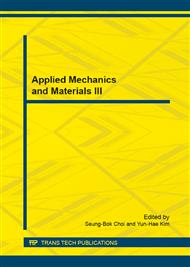[1]
MIWAM, NAKAJIMAA, FUJISHIMAA: Langmuir Vol. 13 (2000), p.5754.
Google Scholar
[2]
NAKAJIMAA, HASHIMOTOK, WATANABET, et al: Langmuir Vol. 16 (2000), p.5754.
Google Scholar
[3]
BHUSHANB, JUNGYC, KOCHK: Langmuir Vol. 25 (2009), p.7044.
Google Scholar
[4]
KULINICHSA, FARHADIS, NOSEK, et al: Langmuir Vol. 27 (2011), p.25.
Google Scholar
[5]
ISHIZAKT, HIEDAJ, SAITON, et al: Electrochim Acta Vol. 55 (2010), p.7094.
Google Scholar
[6]
CARLBORGCF, VANDER WIJINGAARTW: Langmuir Vol. 27 (2011), p.487.
Google Scholar
[7]
BORMASHENKOE, POGREBR, BOAMASHENKOY, et al: Langmuir Vol. 24 (2008), p.12119.
Google Scholar
[8]
BALUB, BERRYAD, HESSDW, et al: Lab Chip (2009).
Google Scholar
[9]
H.Z. Chen, T. Geng, X. Zhang, et al: Chemical Research Vol. 4 (2013), p.434.
Google Scholar
[12]
L. C. Gao, MCCARTHY T J: Langmuir Vol. 23 (2007), p.13243.
Google Scholar
[13]
L. C. Gao, MCCARTHY T J: Langmuir Vol. 23 (2007), p.3762.
Google Scholar
[14]
MCHALE G: Langmuir Vol. 23 (2007), p.8200.
Google Scholar
[15]
J. Zhang, J. Wang, Y. Zhao, et al: Soft Matter Vol. 4 (2008), p.2232.
Google Scholar
[16]
YOON Y I, MOON H S, LYOO W S, et al: J Colloid Interface Sci Vol. 320 (2008), p.91.
Google Scholar
[17]
Y. Xiu, HESS D W, WONG C P: J Colloid Interface Sci Vol. 326 (2008), p.465.
Google Scholar
[18]
TAERINO R, FABBRI E, MESS ORI M, et al: J Colloid Interface Sci Vol. 325 (2008), p.149.
Google Scholar
[19]
MANCA M, CORTESE B, VIOLA I, et al: Langmuir Vol. 24 (2008), p.1833.
Google Scholar
[20]
W. Wu, M. Chen, S. Liang, et al: J Colloid Interface Sci Vol. 326 (2008), p.478.
Google Scholar
[21]
L. Zhao, Q. Liu, R. Gao, et al: Corrosion Science Vol. 80 (2014), p.177.
Google Scholar
[22]
Y. Liu, X. Yin, Zhang. J, et al: Electrochimica Acta Vol. 125 (2014), p.395.
Google Scholar
[23]
Mahajan M, Bhargava S K, O'Mullane A P: Electrochimica Acta Vol. 101 (2013), p.186.
Google Scholar
[24]
YOON H, PARK J H, KIMG H: Macromol Rapid Commun Vol. 2010, 31 (16): 1435-1439.
Google Scholar
[25]
PISUCHPEN T, CHAIM-NGOEN N, INTASANTA N, et al: Langmuir Vol. 27 (2011), p.3654.
DOI: 10.1021/la104978e
Google Scholar
[26]
BERENDJCHI A: Nanoscale Res Lett Vol. 6 (2011), p.594.
Google Scholar
[27]
X. S. Cai, X. Y. Xiao: Modern Chemical Industry Vol. 1 (2013), p.22.
Google Scholar
[28]
W. Yang, B. Pei, H. Guo, et al: Journal o f Northwest Normal University ( Natural Science) Vol. 3 (2011), p.54.
Google Scholar
[29]
T. S. Yang, H. Tian, Y. Q. Chen: J Sol-Gel Sci Techn Vol. 49 (2009), p.243.
Google Scholar


